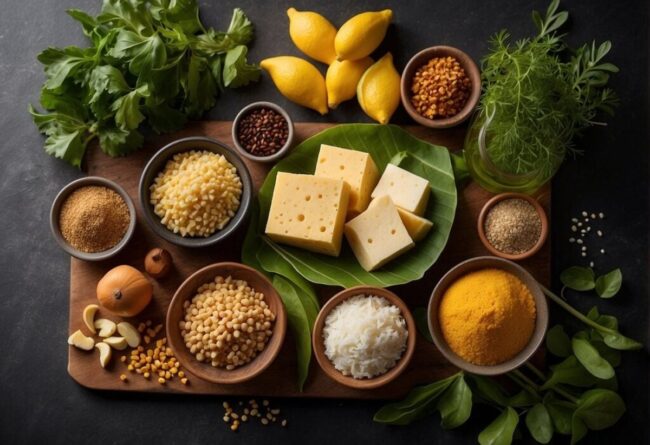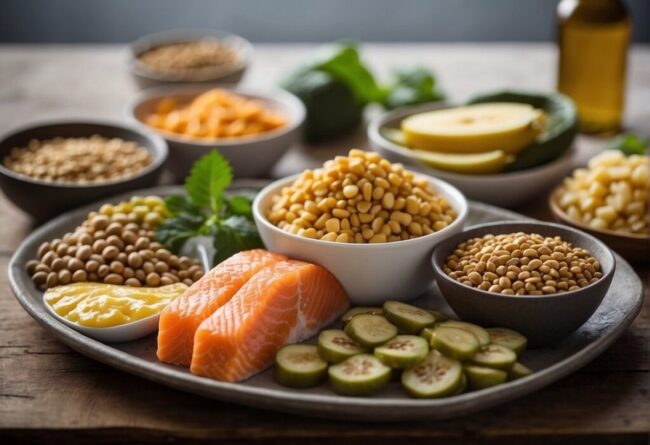3 Budget-Friendly Salmon Replacements to Try
Salmon substitutes make sure meals remain rich and satisfying even without this popular fish.
Some options bring the same buttery texture, while others provide a leaner, lighter alternative.
Whether grilled, smoked, or baked, the right swap keeps the dish flavorful.
Finding a replacement that holds its texture ensures the perfect bite every time.
What to Know About Salmon
Salmon is a fatty fish known for its rich flavor and high omega-3 content. It is a favorite in grilling, baking, and raw preparations.
Salmon Nutrition Facts
Nutrients in salmon play a significant role in maintaining overall health.
This fish serves as an excellent source of high-quality protein, supporting muscle recovery and tissue repair.
Essential omega-3 fatty acids promote heart wellness and help reduce inflammation throughout the body.
Vitamin D is another important component, contributing to strong bones and a robust immune system.
Salmon also contains valuable minerals like selenium, which acts as an antioxidant; phosphorus for healthy bones; and potassium to help manage blood pressure levels.
The fat content varies by species but typically includes beneficial monounsaturated and polyunsaturated fats that support good health.
Types of Salmon
Salmon comes in various species, each with unique traits.
The two primary types originate from the Atlantic and Pacific Oceans.
Pacific salmon includes sockeye, king, and coho varieties, offering different flavors and textures.
For instance, Atlantic salmon is usually farmed with a mild taste and moderate fat content.
Sockeye stands out for its vibrant color and rich flavor but has less fat compared to others.
King salmon features a buttery texture due to its high-fat content while coho presents a lighter flavor combined with a firm texture.
Knowing these differences helps in choosing the best option based on personal tastes or health benefits like omega-3 fatty acids.
The Overview of Salmon Substitutes
Salmon substitutes vary in texture and fat content, with options like trout, steelhead, or Arctic char. Choosing the right one ensures similar cooking results.
Flavor Showdown
Salmon features a rich and fatty taste that many people recognize.
For those who prefer something less intense, Arctic char offers a similar flavor without the strong profile of salmon.
Pollack and hake present another option, showcasing white meat that differs from salmon's pink color while maintaining a mild taste.
Cod and halibut come next with their neutral flavors, allowing seasonings to shine through for an enjoyable seafood meal.
Each of these fish provides its own unique experience on the plate while catering to various palates.
Surface Texture Study
Substituting salmon opens up a variety of seafood choices that maintain a similar texture.
Halibut offers a firm consistency, making it easy to prepare through methods like searing or poaching.
Cod features a slightly softer texture but still provides flakiness and holds up nicely in many cooking techniques suitable for salmon.
When looking for alternatives, these fish can match the appealing characteristics of salmon while offering unique flavors ranging from subtle to more pronounced.
This versatility allows you to adjust your recipes according to personal tastes and preferences, enhancing your culinary experience with different seafood options.
Best Fish Replacement Options
Popular fish alternatives provide similar textures and flavors for different recipes. They offer a sustainable choice without compromising on taste.
Tuna
With its hearty texture and bold taste, tuna stands out as a versatile ingredient.
Skipjack or Yellowfin tuna works wonderfully in salads and light dishes, offering a fresh option for any meal.
For those who enjoy searing fish or making steak-like meals, Bluefin or Bigeye tuna provides an excellent alternative to grilled or baked salmon.
Each type brings its own unique qualities to the table, enhancing any culinary experience with rich flavors.
Whether preparing a simple salad or an elegant steak dinner, incorporating these tunas adds depth and satisfaction to your dishes.
Trout
Steelhead trout offers a bold flavor that works well in richer recipes, making it a great alternative to salmon.
Rainbow trout has a gentler taste and pairs nicely with various dishes meant for salmon.
Both types of trout share textures and flavors similar to salmon, which is why they are often suggested as substitutes.
Their versatility allows cooks to adapt traditional salmon recipes with ease while still enjoying delicious results.
Choosing these fish opens up exciting culinary options for those looking to diversify their meals without sacrificing taste.
Other White Fish
For lighter dishes or recipes needing small fish pieces, sardines and herring serve as excellent substitutes for salmon in salads or pasta.
Flounder and sole, both delicate flatfish with a gentle taste, work wonderfully when pan-fried or baked.
Cod stands out as a flaky white fish that can be prepared by baking or frying.
Hake shares similarities with cod but offers a mildly sweet flavor that adapts well to different seasonings.
Pollock’s mild taste makes it versatile; it often appears in dishes like fish sticks and imitation crab cakes.
Snapper adds firmness to meals while providing a unique nutty flavor profile that complements various ingredients beautifully.
Cooking with Salmon Replacements
Cooking with salmon replacements requires understanding how different fish react to heat and seasonings. The right substitute balances flavor and moisture retention.
Cooking on Grill and Oven
Dense fish fillets like Spanish mackerel work wonderfully for grilling and baking.
Their hearty texture closely resembles that of salmon, making them a satisfying choice.
For grilling, oil the fish generously to avoid sticking; cook each side for about 3-4 minutes based on thickness.
When opting for baking, preheat the oven to 400°F and bake the fillets for 10-15 minutes.
Adjust cooking times according to how thick the fillet is to ensure thorough cooking without drying it out.
This method guarantees delicious results every time you prepare these flavorful options.
Grilling and Simmering
Delicate fish like Pollack shines with poaching, a method that allows flavors from the cooking liquid to infuse gently.
This technique involves bringing water or broth to a simmer before adding the fish and cooking it for 8-10 minutes.
For those looking for a crispy finish, broiling provides an excellent option.
A broiler heats quickly; placing oily fillets like mackerel or hake just 4-6 inches from the heat source ensures they stay moist while developing that desired texture.
Watching closely during this process is essential, as overcooking can easily happen in just 5-7 minutes.
Tacos and Bakes
Firmer fish works best in casseroles since it maintains its shape during cooking.
Hake is an excellent choice for this dish; combining it with other ingredients before baking creates a hearty meal.
Fish like Pollack shines in tacos due to its ability to absorb bold taco flavors and flake easily.
For tacos, gently slow-roasting the fish enhances the overall taste, allowing for a delightful pairing with your favorite toppings.
This combination makes both dishes satisfying and flavorful while showcasing the versatility of different types of fish in various meals.
Dietary Considerations for Substitutes
Some salmon substitutes cater to dietary needs, including sustainable seafood options. Choosing responsibly sourced fish ensures environmental benefits and great taste.
Meat Alternatives for Vegetarians
Vegetarian diets can still provide the nutrients found in salmon.
Flaxseeds and chia seeds deliver a strong dose of Omega-3 fatty acids, essential for heart health.
Vitamin D can be obtained from fortified options like specific plant-based milks and cereals, ensuring strong bones and overall well-being.
Seaweed offers a unique flavor reminiscent of seafood while also being rich in nutrients.
Algae-based supplements serve as an excellent alternative to fish products for those following plant-focused eating habits.
Embracing these ingredients guarantees a wholesome approach to nutrition without sacrificing dietary preferences.
Allergies and Mercury Levels
Choosing the right substitute for fish can greatly impact your health, especially for those with fish allergies or concerns about mercury.
Lean poultry like chicken and turkey provides essential protein and vitamins.
Smaller options such as sardines or shrimp are good alternatives if shellfish allergies aren’t an issue, offering beneficial omega-3 fatty acids.
Most fish contain some mercury; however, levels are often low enough to be safe for consumption.
Consulting a healthcare provider helps ensure that you make informed choices tailored to your needs.
A balanced diet plays a vital role in strengthening the immune system and promoting overall well-being.


